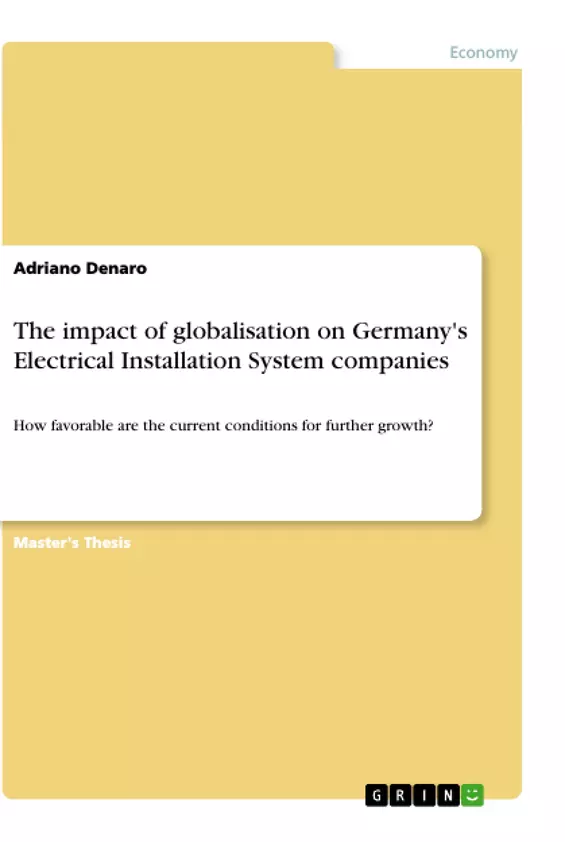This thesis aims to research the question: does globalization impact the strategies of the German Electrical Installation companies, and how are the conditions for further growth?
This thesis conducted a mixed-method approach to achieve this research aim. For the theoretical sensitivity, this study uses PESTEL,- Yip's Internationalisation Driver ́s as well as Porter's Five Forces Framework followed by survey research. Building upon these, a survey was conducted within the German electrical industry to research on the study's research question empirically. With obtaining these empirical data, this thesis gained management and expert insights. Based on the research objectives the evaluation represents that with this survey it was possible to identify, discuss and analyze the strategic position, the strategic choices, and the conditions for further growth of Germany ́s Electrical Installation System companies. The first main recognition gained in this dissertation is that innovation projects such as the project Industry 4.0 from the German Federal Government, is not considered in the strategies of German Electrical Installation companies. This is a disadvantage because other nations working intensively on this topic. This is seen most critical for the future of the German Electric Industry. The recommendation is to rework the current strategies and to include innovation projects such as the project Industry 4.0. The next important outcome of the elaboration is that the globalisation affects the strategies of German Electrical Installation companies and the companies under research have no really internationalisation strategy, although they are international active. The survey shows that the essential inputs of the respondents lead to a preferred internationalisation strategy. The simple export. This result with respect to the respondents which have a strategy leads not only to advantages, but also it leads to disadvantages. The advantages are on the one hand cost aspects. There are no operational facilities needed in the host country and by using the Internet they are able to gain access into the international market. But on the other hand this strategy does not allow the firm to benefit from the location advantages of the host nation and limits the opportunities to gain knowledge of the local market and respectively of the customers.
Inhaltsverzeichnis (Table of Contents)
- Abstract
- Introduction
- Management Issues
- Thesis aims
- Research design
- Thesis Structure
- Review of current thinking
- Ethical reflection
- Theoretical framework
- PESTEL
- Yip's Internationalisation Driver's
- Porter's Five Forces
- Market entry modes
- The International Strategies
- The Theories - a summary
- Methodology
- Research method
- Ethical issues
- Critical Review
- Data collection
- Industry focus
- The German Electrical Installation System Market as target group
- Assumptions
- Design of Questionnaire
- General Information
- Strategic Position
- Strategic Choices
- Further Growth
- Survey respondents
- Structure of sample
- Investigation Barriers
- Data analysis
- General Information
- Strategic Position
- Which are the external environmental factors on the strategy of Germen Electrical Installation System companies?
- Which influences have competitors or suppliers in connection with globalisation on their strategy?
- What are the globalised markets where GEISC are noticeable active?
- Strategic Choices
- Does GEISC have internationalisation strategies?
- What are the globalisation strategies pursued by the German electric installation system companies?
- How favourable are the conditions for further growth?
- Secondary data analysis
- Employees Trend
- Turnover trend
- Survey interpretation and findings
- General
- Strategic Position
- Strategic Choices
- Further Growth
Zielsetzung und Themenschwerpunkte (Objectives and Key Themes)
This dissertation examines the impact of globalization on the strategies of German Electrical Installation System (GEISC) companies and assesses the current conditions for further growth. The study aims to provide insights into the strategic challenges and opportunities faced by GEISC in a globalized market.
- The role of globalization in shaping the strategies of GEISC
- Analysis of external environmental factors impacting GEISC strategies
- Identification of key globalisation strategies employed by GEISC
- Evaluation of the current conditions for further growth of GEISC
- Exploration of the relationship between globalization and the competitive landscape for GEISC
Zusammenfassung der Kapitel (Chapter Summaries)
- Introduction: This chapter introduces the research topic, outlining the dissertation's aims, research design, and structure. It highlights the significance of globalisation for the electrical installation industry.
- Review of current thinking: This chapter presents a comprehensive overview of existing research and theoretical frameworks relevant to the study. It examines the ethical implications of globalisation and its influence on businesses.
- Theoretical framework: This chapter introduces key theoretical frameworks, such as PESTEL analysis, Yip's Internationalisation Driver's, Porter's Five Forces, and market entry modes. It lays the foundation for understanding the theoretical underpinnings of the research.
- Methodology: This chapter explains the research methodology employed, including the research method, ethical considerations, and a critical review of the chosen approach.
- Data collection: This chapter details the process of data collection, focusing on the industry focus, assumptions, and the design of the questionnaire. It describes the survey respondents and the structure of the sample.
- Data analysis: This chapter presents the results of the data analysis, exploring the general information gathered, strategic position of GEISC companies, their strategic choices, and the conditions for further growth. It also includes an analysis of secondary data.
- Survey interpretation and findings: This chapter interprets the survey results and provides a detailed analysis of the findings. It examines the general trends observed, strategic positions, strategic choices, and the potential for further growth.
Schlüsselwörter (Keywords)
This research focuses on globalisation, strategic management, electrical installation systems, German companies, market entry modes, internationalisation strategies, PESTEL analysis, Yip's Internationalisation Driver's, Porter's Five Forces, and further growth opportunities.
- Arbeit zitieren
- Adriano Denaro (Autor:in), 2015, The impact of globalisation on Germany's Electrical Installation System companies, München, GRIN Verlag, https://www.grin.com/document/935817



